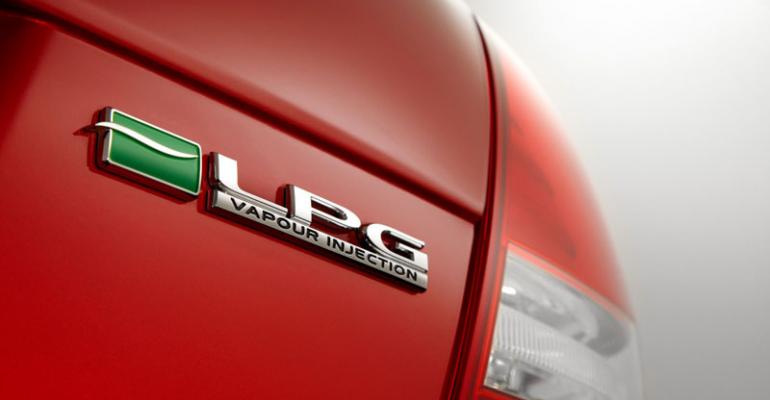Production of the all-new dedicated LPG Commodore launches at GM Holden’s Vehicle Operations in Elizabeth, South Australia.
The liquefied-petroleum-gas system, which is available for the Commodore sedan, sport wagon, pickup and long-wheelbase models, comes after an intensive engineering project that clocked up more than 810,000 development miles (1.3 million km) to deliver a vehicle designed for Australian conditions and driving tastes.
The program resulted in numerous engineering solutions with several patents awarded.
The heart of the LPG Commodore is its 3.6L double-overhead-cam V-6 engine with four valves per cylinder specifically developed to run on LPG.
LPG is sourced and refined in Australia, and typically costs at least 30% less than gasoline while producing 10% to 15% less carbon-dioxide and substantially fewer hydrocarbon emissions.
The Omega LPG sedan has a range of more than 435 miles (700 km) to ensure “range anxiety” is not an issue. The auto maker says that with more than 3,300 metropolitan and rural LPG outlets nationwide, Australia’s LPG infrastructure is extensive and well-established.
Brian McMurray, program engineering manager for the LPG Commodore program, says engineers had three crucial targets: class-leading CO2 emissions; fuel running costs comparable with, or better than, those of many small gasoline-powered cars; and a driving experience in line with gasoline-powered Commodore models.
“I’m very proud to say that the team has achieved, or exceeded, those goals,” McMurray says in a statement. “After more than 1.3 million development km and 78 testing and evaluation prototypes, the Holden engineering team has executed a no-compromise LPG experience.”
Because the engine is designed to run only on LPG, the fuel system features newly developed fuel injectors, fuel rail and fuel filter.
The auto maker says specific fuel injectors are target-positioned within the engine to optimize fuel delivery, giving better performance and lower CO2 emissions.
Additional highlights include hardened valves and valve seats to ensure long-term durability, while the heads and manifold also are designed specifically for the LPG Commodore to ensure optimized air flow and combustion.
Newly designed pistons raise the compression ratio to 12.2:1 to take full advantage of LPG fuel, which contains a higher octane rating than gasoline.
GM Holden engineers who evaluated liquid and vapor-injection LPG systems say that after building a proof-of-concept liquid-injection prototype vehicle, they realized vapor injection was the only way to meet the program’s goals.
“Vapor injection provides lower fuel consumption and lower CO2 emissions compared to liquid, while vapor also uses fuel more efficiently, with fewer pumping and parasitic losses,” McMurray says. “Vapor is also best-suited to the Australian climate, with more consistent startup in hot climatic conditions.”
As well, vapor systems are less mechanically demanding and better suited to the varying grades of LPG fuel found across Australia.
GM Holden says a purpose-designed vaporizer regulates the flow of LPG, subsequently heating the fuel and vaporizing it before it is injected into the combustion chamber. The vaporizer is the only one of its type being used by any OEM manufacturer on an engine of this capacity.
Engineers had to create and execute new software to operate the vaporizer and integrate it into the powertrain system. The auto maker says the result is an engine with excellent performance and outstanding fuel economy.
Producing 240 hp and 235 lb.-ft. (320 Nm) of torque, the dedicated LPG engine eclipses the outgoing dual-fuel LPG variant by 6.7 hp and 2 lb.-ft. (1.5 Nm). This gives the LPG-powered sedan a fuel economy of 19.9 mpg (11.8 L/100 km) on the Australian Design Rules combined cycle, a 13% improvement over the outgoing model.
The Commodore LPG sedan emits 189 g/km of CO2, the lowest figure of any locally built 6-cyl. sedan, GM Holden says. The entire range earns a 4.5-out-of-5 score in the Green Vehicle Guide and exceeds stringent Beyond Euro 6 exhaust-emissions standards.
A new and lighter, more refined 6-speed automatic transmission boasts sophisticated control software that optimizes shift patterns. Depending on fuel prices, the Omega LPG sedan will cost less than A$1,300 ($1,384) a year in fuel to run, which GM Holden says is up to A$800 ($852) less than a gasoline-powered 1.8L Toyota Corolla.
LPG requires a larger tank than gasoline to achieve a similar range, so to keep mass contained, GM Holden’s safety engineers developed a lightweight, 22.2-gallon (84-L) aluminum tank they say to their knowledge is the industry’s only mass-produced, OEM-equipped aluminum fuel tank.
The tank is made from high-strength, multi-celled, aircraft-grade extruded aluminum with additional aluminum protection plates.
To balance mass and weight distribution with safety requirements, engineers relocated the tank behind the rear axle, which required significant re-routing of the exhaust system. Relocating the tank also maximizes trunk space, addressing a traditional shortcoming of most LPG vehicles.
The tank was the subject of extensive research-and-development activity, including numerous simulated and physical tests of both the tank by itself and within the vehicle, in the form of nine barrier crash tests.
The LPG Commodore range will be available at dealerships beginning in March.
GM Holden has set the LPG option price A$2,500 ($3,661) above the cost of gasoline models, but notes private buyers of new factory-fitted LPG vehicles can apply for a A$2,000 ($2,129) federal-government rebate.





